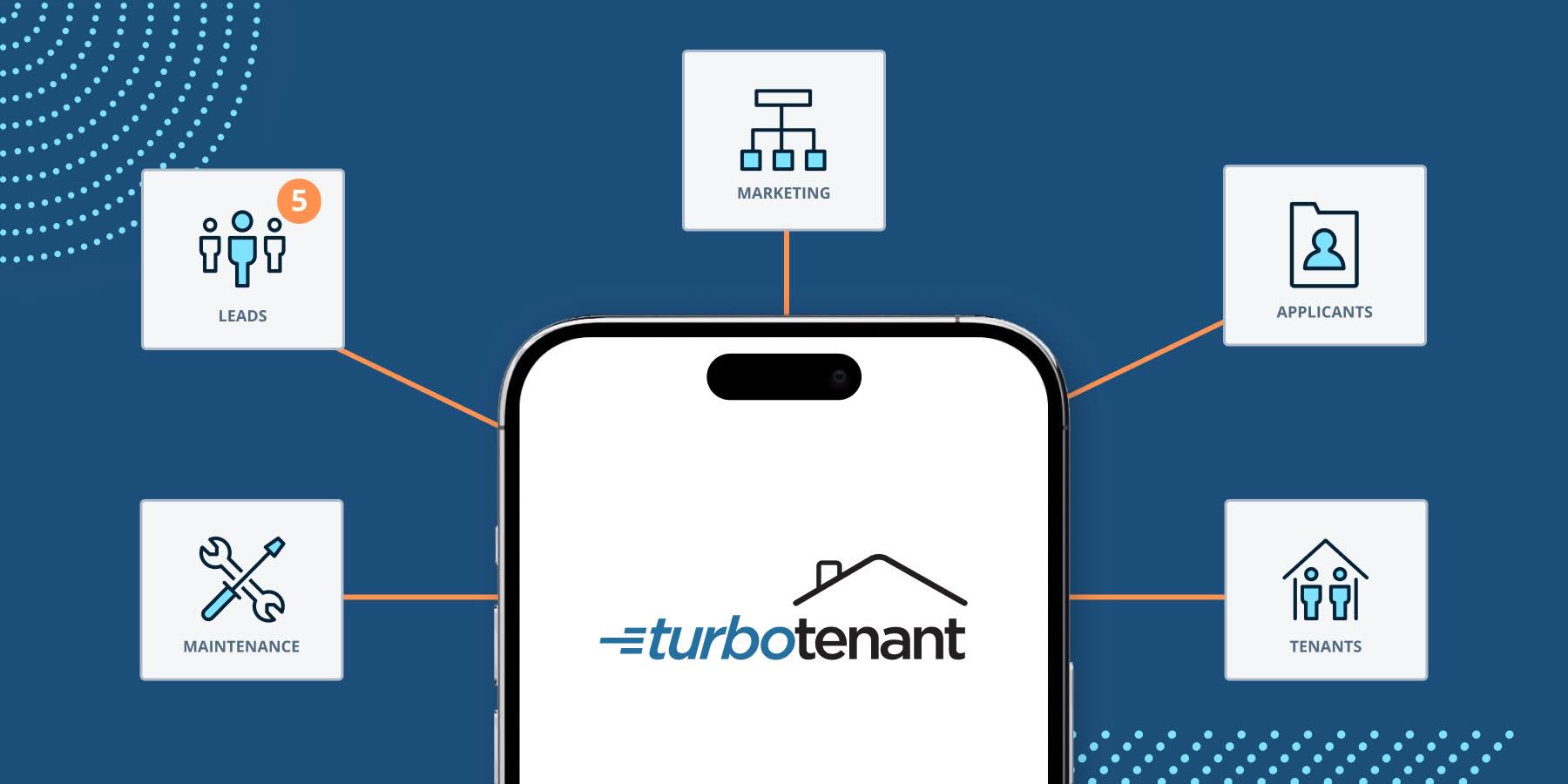If you’ve been wondering how to be a landlord in Texas, you’ve come to the right place. Maybe you inherited a property you don’t want to sell, or perhaps it’s been a long-time dream to build a portfolio of rental units.
You may want to rent a room in your home for extra cash. Whatever your reasons, becoming a landlord is easy, as long as you have the right tools and knowledge.
In this guide, we’ll walk through the steps you’ll need to take before you hand over the keys. From doing the necessary research to understanding landlord-tenant law, TurboTenant is here to make sure your landlording experience is smooth and profitable.
A TurboTenant account unlocks comprehensive tenant screening, document storage, expense tracking, and everything else landlords need.
Research The Market
Now that you’re ready to learn how to be a landlord in Texas, it’s time to crack open the books — or web browser. Research the area as thoroughly as possible to ensure you’re correctly pricing your rental and following all local laws and guidelines. Don’t assume you’re an expert just because you might live in the area.
Researching the market means gathering data on things like:
- The current and historic state of the job market
- Population growth over the last few years
- General economic stability of the area
- Ongoing real estate market trends
- Quality of the neighborhood and proximity to transportation, shopping, and entertainment
- General inventory of nearby rental properties
- Average rents for comparable properties
Knowing whether your rental location requires a rental license or inspections before listing the property is essential. Some areas, like San Marcos and Sugar Land, require rental licensing. Be sure to check the local laws in your area.
Once you’ve gained a solid knowledge base about the market, it’s time to grab the calculator and run some numbers.
Do Some Math
Whether starting with one unit or building a portfolio, understanding the math behind your investment is critical to finding long-term success as a Texas landlord. The property might be in tip-top shape and move-in ready, or it might need substantial renovation to bring it up to snuff — either way, you’ll need to do the math.
You’ve done the market research, so you might have a good idea of your gross rent based on your comps. But digging deep into the numbers can turn a moderately successful portfolio into a massively profitable machine.
TurboTenant offers landlords a number of powerful calculators to make you a rental math wizard by providing guidance on key figures like:
- Capitalization rate
- Rental yield
- Rental property ROI
- Cashflow calculations
Remember to build in some contingency planning around unplanned maintenance and vacancies that run longer than you’d like. Properly forecasting for every situation can make a big difference in your annual revenue.
Read Up On Local Landlord-Tenant Law
Becoming a landlord also means knowing the letter of the law regarding renting out property. That includes reading and following laws like the Federal Fair Housing Act, the Americans with Disabilities Act, the Fair Credit Reporting Act, and the Servicemembers Relief Act, among others. But beyond just federal guidelines, each state passes its own landlord-tenant laws, which landlords must follow.
Security deposit rules: Texas does not limit the amount landlords can charge for security deposits, nor does it require landlords to issue a receipt or pay interest on the deposits. Further, landlords must return funds to the tenant within 30 days of the lease ending.
Entry requirements: Texas landlords can enter the property as they see fit and are not required to provide advance notice, though a 24-hour warning is common.
Eviction laws: Texas law does not require landlords to give the tenant a chance to cure a lease violation or unpaid rent. In either case, they can immediately issue a 3-day notice to quit before proceeding through the legal eviction process with the court system.
Rent control: There is no rent control or rent stabilization in Texas.
Lease breaking: In Texas, breaking a lease without penalty can only happen in a few circumstances, like entering active military duty, landlord harassment, domestic violence, or tenant death, among others. If a tenant breaks the lease for a non-qualifying reason, they could be responsible for the remaining rent on the lease term or until you fill the now-vacant unit with a new tenant.
Use Property Management Software
Learning how to be a landlord in Texas isn’t just about knowing the law. It’s really about the day-to-day operation of renting out your properties, which can quickly become overwhelming, no matter how many properties you own.
Property management software, like TurboTenant, can be massively helpful to landlords and become a valuable tool in their arsenal. With a competent software platform, you can centralize your landlord work in one, easy-to-use dashboard, saving you time and money when you need it most. It can also help you securely store documents, improve communication between you and your tenant, and stay compliant at all times.
Use a Legally Compliant Lease
A lease agreement is the guiding light in property rental, providing landlords and tenants with the roadmap for the rental term, which makes it incredibly important. Eschewing a written lease or grabbing a random one from the internet is far too risky and could lead to serious issues.
TurboTenant has a database of legally reviewed lease agreement templates for all 50 states that landlords can download and customize. With a modest upgrade from the free account, you can get unlimited leases and the ability to e-sign for even more convenience and time savings.
Market Your Property
What good is a rental property if no one knows it’s there, right? Marketing your rental unit to ensure it reaches as many qualified renters as possible is a key component of becoming a Texas landlord.
Create a unique ad that stands out from the rest. Make sure your language and marketing copy comply with the Fair Housing Act. Use attractive photos highlighting the property’s best features and amenities or special features. You can even use TurboTenant to build your listings with our AI tool and then blast the listing out to dozens of syndicated listing sites directly from the platform.
Collect Rental Applications Digitally
Never print another rental application again with TurboTenant. Online applications are one of the easiest and best ways to collect critical information about potential renters while avoiding having to sift through endless stacks of paper to find the one you like the most.
From our secure platform, you can easily send applicants links to the online application, allowing them to complete the form on their phone or laptop. Once you’ve received them, a digital application makes it easy to make quick, side-by-side comparisons and then move directly into the screening process once you’ve identified the best candidates.
Screen Tenants Thoroughly
A solid and thorough tenant screening process is a great way to ensure you’re filling your units with high-quality tenants and gives you some peace of mind at the same time. TurboTenant allows you to screen tenants to check criminal history, rental history, and evictions (TurboTenant checks over 27 million records!), financial information, like credit score and lines of credit, and even income verification if you want to upgrade. The background check cost is typically passed on to the tenant and is a vital tool for landlords of all kinds.
To avoid FHA violations, consistent screening criteria must be used for every applicant. Texas law requires landlords to give all applicants a written copy of their selection criteria before accepting the application fee.
Lock Down Maintenance Requests
By using a comprehensive platform like TurboTenant, landlords can easily streamline and organize maintenance requests directly within the dashboard. Tenants can submit requests for maintenance needs from their phones, which can be sent to you or routed directly to Lula’s vetted maintenance team if you upgrade to Maintenance Plus.
A well-maintained unit is a way to keep your tenants happy; it’s also the law. Texas law requires landlords to promptly respond to emergency maintenance requests to keep the unit habitable. Failing to address needed maintenance promptly could allow the tenant to deduct funds from rent payments, terminate the lease, or even sue for damages, so make sure you stay on top with TurboTenant.
Collect Rent Online
Collecting rent from your tenants is arguably the most important part of learning how to be a landlord in Texas. Once upon a time, landlords had to go door-to-door to collect rent checks or wait for them to arrive in the mail. But why wait? With TurboTenant, you can collect rent online, which is far easier and time-saving than the alternative.
TurboTenant lets your tenants set up autopay, so funds are automatically deposited in your account when rent is due. You can also set up automated rent reminders and instruct the platform to assign late fees to a tenant’s account once the payment is overdue. It’s also incredibly easy to track who’s on time and who’s late, as the payments update within the platform instantly.
Streamline Rental Property Accounting
Now that you’ve come this far, don’t let your hard work go to waste by choosing a clunky and inefficient accounting solution to keep track of your cash flow and expenses. While QuickBooks is a general industry standard for accounting, it requires quite a bit of tinkering to optimize it for rental accounting.
TurboTenant features a robust suite of accounting tools that let you easily track revenues, generate reports, and do it on a per-property basis. All of this directly connects to your bank accounts. Keeping everything in one place also makes it much easier to wrangle all of your financial data when tax time rolls around, making a normally frustrating time of year a breeze.
TurboTenant Makes DIY Landlording Easy
In seeking to learn how to be a landlord in Texas, we’ve covered a lot of ground. Let’s review:
- Do your research. Understanding how your rental property fits into your real estate market is crucial to setting the right rent, advertising it the right way, and finding the right tenants.
- Do the math. Use your research to optimize your rent price and forecast your cash flow throughout the year to make smart decisions.
- Learn the laws. Navigating federal and state landlord-tenant laws will keep you legally compliant and your tenants happy.
- Use TurboTenant to make your life easier. Property management software will organize and handle your day-to-day landlord duties, saving you time, money, and energy. It gives you access to lease agreement templates, marketing tools, maintenance tracking, and online rent collection.
Now that you’ve learned how to be a landlord in Texas, get out there and make some dough. Sign up today!




